Both men provided services vital to a nascent frontier town. One turned out lumber and flour. The other set broken bones, stitched wounds, and treated ague and chilblains and jaundice.
 Julian Feild (1825–1897) came to Fort Worth in 1853 from Virginia by way of Harrison County (Marshall), where he was listed in the 1850 census as a farmer.
Julian Feild (1825–1897) came to Fort Worth in 1853 from Virginia by way of Harrison County (Marshall), where he was listed in the 1850 census as a farmer.
 In 1850 Carroll Marion Peak (1828-1885) was still in his native Kentucky (Gallatin County) but at age twenty-one was already a physician. He came to Fort Worth from Kentucky via Dallas in 1853 shortly after Feild arrived in Fort Worth.
In 1850 Carroll Marion Peak (1828-1885) was still in his native Kentucky (Gallatin County) but at age twenty-one was already a physician. He came to Fort Worth from Kentucky via Dallas in 1853 shortly after Feild arrived in Fort Worth.
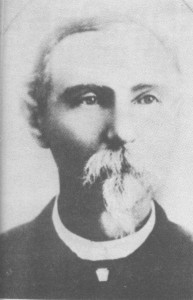 Feild arrived in Fort Worth just as the Army had abandoned the fort. He moved into one of the fort’s vacant buildings and set up a trading post. Feild had brought with him from Dallas a meager inventory of goods: coffee grinders, bolts of cloth, hand tools, sugar, salt.
Feild arrived in Fort Worth just as the Army had abandoned the fort. He moved into one of the fort’s vacant buildings and set up a trading post. Feild had brought with him from Dallas a meager inventory of goods: coffee grinders, bolts of cloth, hand tools, sugar, salt.
With his arrival the tiny civilian settlement had doubled its number of trading posts: In 1849 Henry Clay Daggett and Archibald Leonard had set up a trading post under a big live oak tree just east of today’s Samuels Avenue. When the Army had abandoned the fort, Daggett and Leonard, too, had moved into one of the fort’s vacant buildings. Like Daggett and Leonard, Feild traded with white settlers and with Native Americans. His inventory was replenished by deliveries by ox wagon from east Texas and Louisiana.
But soon after Feild moved to Fort Worth, Julia Kathryn Garrett writes in Fort Worth: A Frontier Triumph, Feild was stricken with a fever. The tiny civilian settlement had no doctor, of course, so a doctor was fetched from Dallas. The thirty-mile trip was a long house call for young Doc Peak. In fact, it was a house call that lasted a lifetime.
Dr. Carroll M. Peak cured Feild of the fever. Whereupon Feild and the rest of the handful of Fort Worth residents began a campaign to convince Peak to forsake Dallas, where he was a doctor, in favor of Fort Worth, where he could be the doctor.
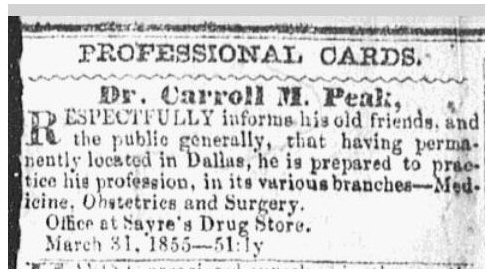 Feild et al. prevailed, and Dr. Peak returned to Dallas only long enough to get his bride, Florence, and make the two-day buggy trip back to Fort Worth. This 1855 classified ad continued to run in the Dallas Herald after Dr. Peak had relocated. The Peaks, too, moved into the abandoned fort. Mr. and Mrs. Peak soon became parents of the first children born in Fort Worth: Clara (1854) and Howard (1856). (When Mrs. Peak died in 1922 at age eighty-nine she had been a resident of Fort Worth longer than anyone else alive at the time.)
Feild et al. prevailed, and Dr. Peak returned to Dallas only long enough to get his bride, Florence, and make the two-day buggy trip back to Fort Worth. This 1855 classified ad continued to run in the Dallas Herald after Dr. Peak had relocated. The Peaks, too, moved into the abandoned fort. Mr. and Mrs. Peak soon became parents of the first children born in Fort Worth: Clara (1854) and Howard (1856). (When Mrs. Peak died in 1922 at age eighty-nine she had been a resident of Fort Worth longer than anyone else alive at the time.)
Dr. Peak began to establish his new practice, which covered a thirty-mile radius. He made his rounds on his horse, Gray Eagle. Among the hardware he carried: an amputation saw, a knife, and a pistol.
He and his wife helped found the oldest surviving church in Fort Worth: First Christian Church, which first met in the Peak home in 1855.
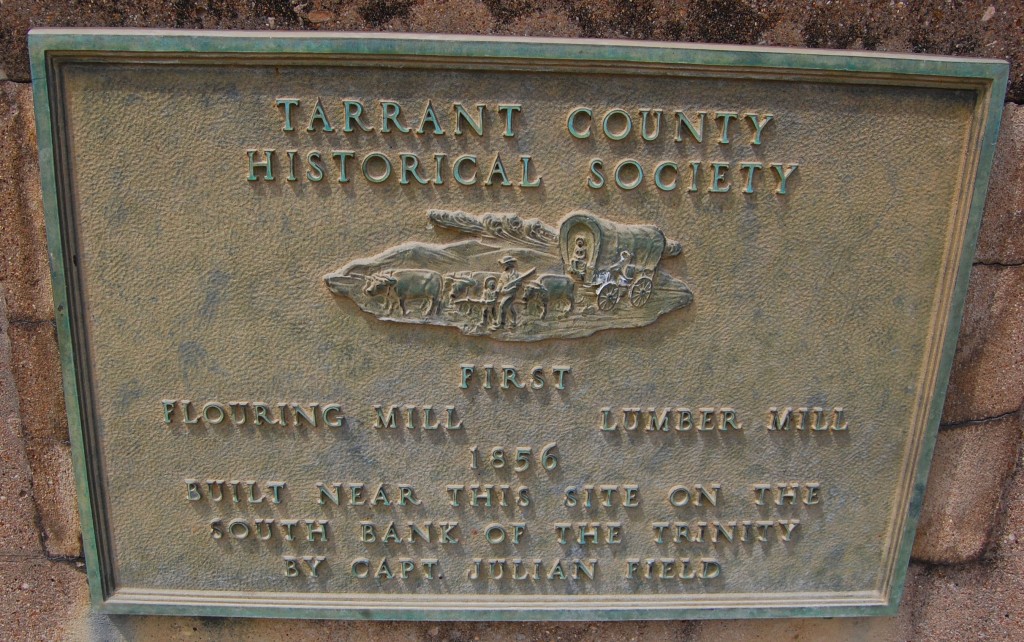 Meanwhile, Julian Feild was diversifying. In 1856 Feild, with David Mauck and R. S. Man, built a gristmill and sawmill on the Clear Fork of the Trinity River near today’s Henderson Street bridge.
Meanwhile, Julian Feild was diversifying. In 1856 Feild, with David Mauck and R. S. Man, built a gristmill and sawmill on the Clear Fork of the Trinity River near today’s Henderson Street bridge.

In the early twentieth century there were streets named “Mill” and “Julian” just south of the river and just west of Henderson Street (Royal Street was renamed “Henderson.”)
 The gristmill ground wheat and corn from surrounding farms into flour and meal and supplied settlers, Native Americans, and Army posts. The sawmill turned timber into lumber. But after two years of drought the river ran too low, and the mills failed.
The gristmill ground wheat and corn from surrounding farms into flour and meal and supplied settlers, Native Americans, and Army posts. The sawmill turned timber into lumber. But after two years of drought the river ran too low, and the mills failed.
That year the Peaks bought a town lot owned by Middleton Tate Johnson on the road to Dallas and moved from the abandoned Army fort. Their new home was located about where the Worthington Hotel is in the block bounded by Weatherford, Houston, 1st, and Throckmorton streets. In one room of that small house Dr. Peak opened the town’s first drugstore. He prescribed cutting-edge medicine: compounded from opium, turpentine, lard, alcohol, mustard, ammonia, honey, sulfuric acid, charcoal, nitrate of silver, ad nauseam. He also treated patients, charging $1.50-$2 for a visit unless there were complications. He charged a dollar to pull a tooth.
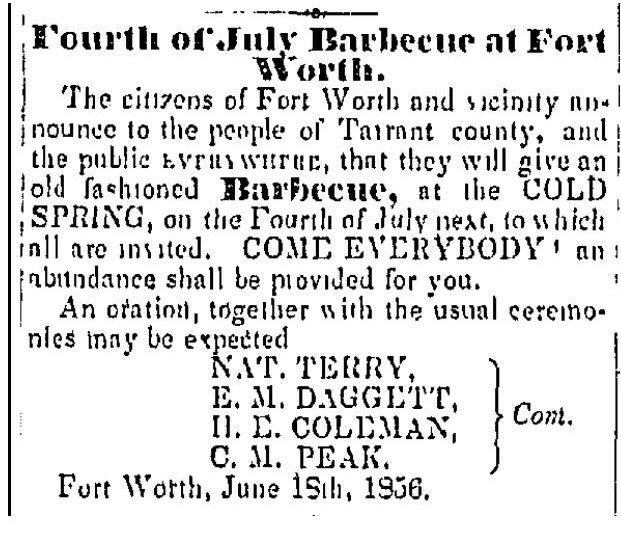 In 1856 Peak was on the committee that organized the town’s Independence Day barbecue at the Cold Springs east of Samuels Avenue.
In 1856 Peak was on the committee that organized the town’s Independence Day barbecue at the Cold Springs east of Samuels Avenue.
Peak also organized the town’s first mail service, paying a rider to go to Dallas twice a week to bring back the mail. Peak charged ten cents a letter. According to Garrett in Fort Worth: A Frontier Triumph, when the town’s first post office opened in 1856, President Franklin Pierce named Julian Feild postmaster. The post office was a wooden shanty on the town square. Later that year stagecoach service began and brought the mail to the post office.
As civic leaders Peak and Feild often worked together as the town grew. Both men worked to guarantee that Fort Worth would build—at no cost to taxpayers—a fine stone-and-brick courthouse should Cowtown prevail over Birdville in the (re-)election in 1856 to select the county seat. On election day Feild kept a barrel of whiskey outside his store to encourage voters to vote for Fort Worth. Votes were tabulated at Dr. Peak’s office.
Both men were trustees of early schools that opened after John Peter Smith closed his school because of poor health. Carroll Peak Elementary School is named for the doctor.
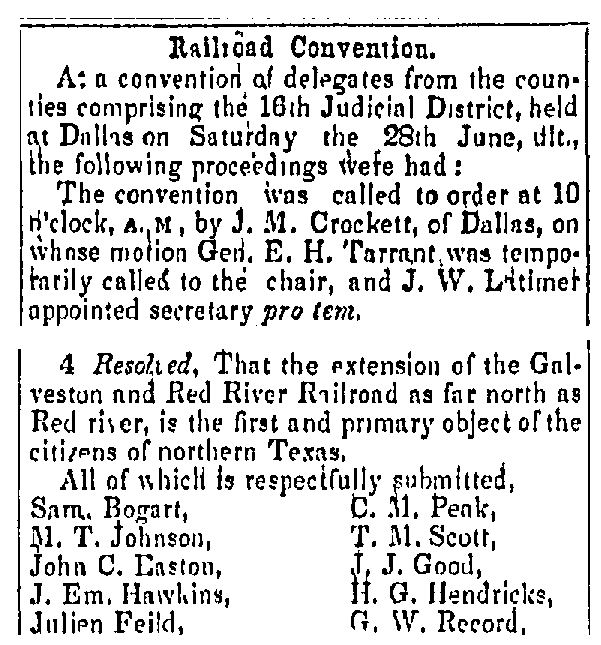 This 1856 Dallas Herald clip shows that both men also campaigned to bring railroads to the area.
This 1856 Dallas Herald clip shows that both men also campaigned to bring railroads to the area.
The town’s first Masonic lodge meeting was held in Feild’s store in 1855. He was elected worshipful master. In 1857 Feild supervised construction of a two-story Masonic lodge hall at East Belknap and Grove streets. Today that lodge, no. 148, meets at the temple on Henderson. Another lodge, no. 908, is named for Feild.
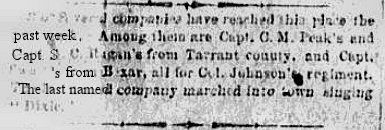 Dr. Peak also remained busy. In 1862 he raised a company of soldiers for the Confederacy in the mounted Tarrant Rifles. This faded notice in the Dallas Herald reports that Dr. Peak’s men had reached Dallas. (I have overtyped the faded print that I could decipher with any certainty.)
Dr. Peak also remained busy. In 1862 he raised a company of soldiers for the Confederacy in the mounted Tarrant Rifles. This faded notice in the Dallas Herald reports that Dr. Peak’s men had reached Dallas. (I have overtyped the faded print that I could decipher with any certainty.)
 After the mill of Feild and R. S. Man in Fort Worth failed, the two men tried again in 1858, building a mill on Walnut Creek southeast of Fort Worth. The new location had plenty of water and fuel, plenty of grain from local farmers. It prospered. Come the Civil War, the mill supplied flour for the Confederacy, and Feild was exempted from military duty. Man and Feild also helped to found the town of—you guessed it—Mansfield, which is named for the two men but with the unusual (and oft-misspelled) spelling of Feild’s surname altered.
After the mill of Feild and R. S. Man in Fort Worth failed, the two men tried again in 1858, building a mill on Walnut Creek southeast of Fort Worth. The new location had plenty of water and fuel, plenty of grain from local farmers. It prospered. Come the Civil War, the mill supplied flour for the Confederacy, and Feild was exempted from military duty. Man and Feild also helped to found the town of—you guessed it—Mansfield, which is named for the two men but with the unusual (and oft-misspelled) spelling of Feild’s surname altered.
The bottom clip shows that the weekly Dallas Herald accepted wheat as payment for subscriptions. (Try that with your local newspaper next month!)
In 1871 Feild was injured when Native Americans ambushed his train of freight wagons carrying flour to the western forts.
In 1877 Dr. Peak helped establish free (tax-supported) public schools, a concept that had not been popular among voters. He was an early school board member. He also served on the city council.
 Julian Feild also served as a city alderman. And in 1885 he was again appointed postmaster. This time he showed his gratitude by naming his new baby after the president. Julian Feild was then sixty years old.
Julian Feild also served as a city alderman. And in 1885 he was again appointed postmaster. This time he showed his gratitude by naming his new baby after the president. Julian Feild was then sixty years old.
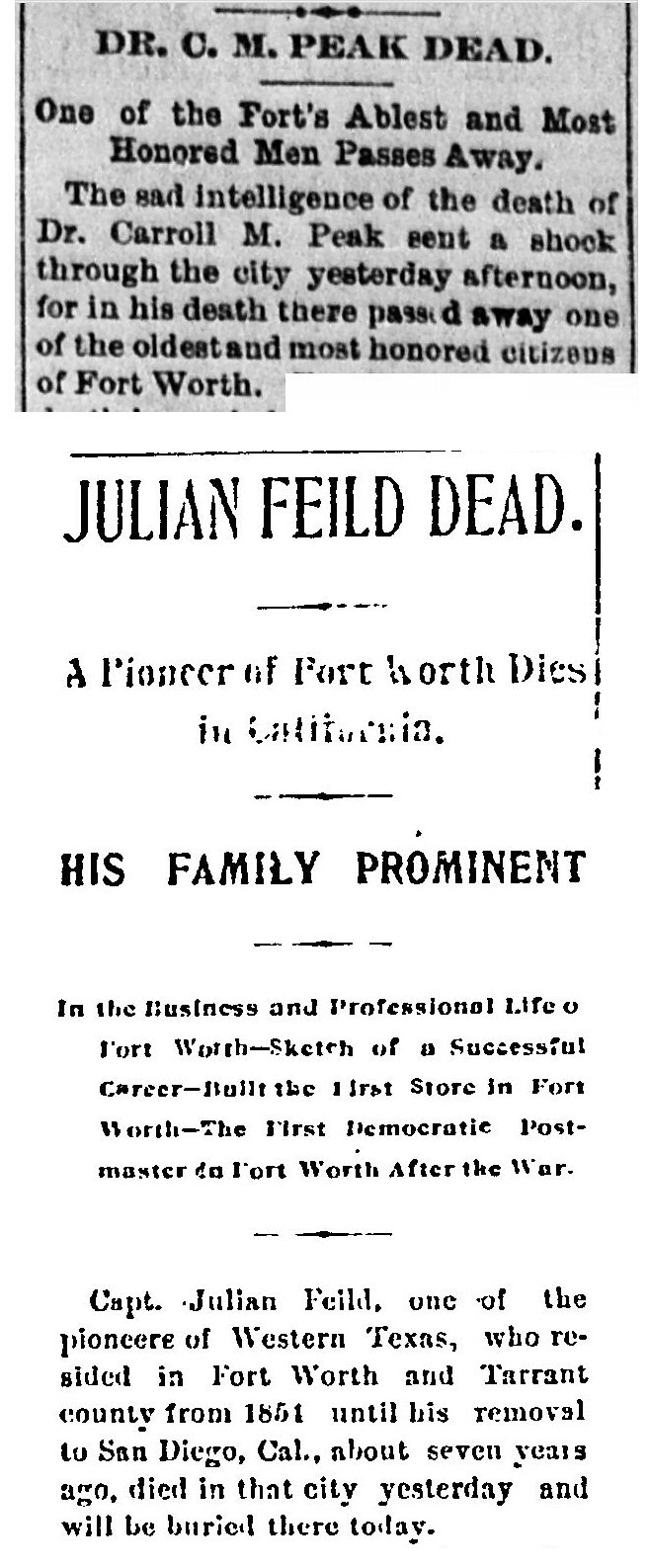 Dr. Carroll M. Peak died on February 27, 1885. About 1890 Julian Feild moved to California, where he died on September 9, 1897.
Dr. Carroll M. Peak died on February 27, 1885. About 1890 Julian Feild moved to California, where he died on September 9, 1897.
 Carroll Peak and his wife are buried in Pioneers Rest Cemetery.
Carroll Peak and his wife are buried in Pioneers Rest Cemetery.
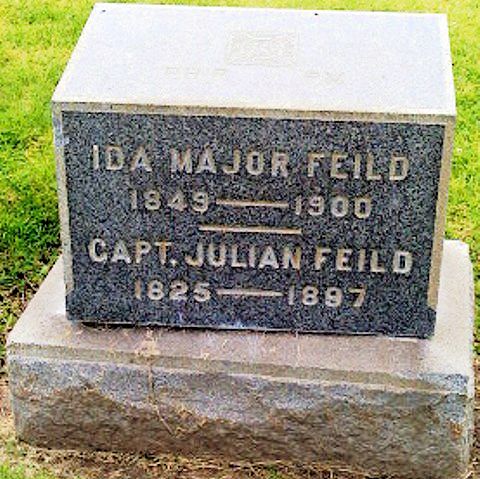 Buried in San Diego, Feild is one of the few founders of Fort Worth who is not buried here.
Buried in San Diego, Feild is one of the few founders of Fort Worth who is not buried here.
Full-circle footnote: Two of Julian Feild’s sons, Julian Theodore and Richard Alexander, would follow in the footsteps of Dr. Carroll Peak—the man who had treated their father for fever in 1854: They became doctors.






Hello, I loved the history of the school. I wanted to know if you had any pictures of the original Carroll Peak Elementary school?
Thank you for visiting the site. Unfortunately the author, Mike Nichols, passed away and we are working on how best to preserve this informative site.
A peak of interest, with an unveil of origination that is surreal. The days of Log Cabins and Blacksmiths left a note for the future generations to unveil an awaken.
Looking for photo and history of the chapel on the Masonic Home property of about 200 acres.
I understand that Bell Chapel may be that building but the location puzzles me. Thanks.
K Roper, Belltower Chapel was built in 1958. Photo here.
Website here.
I really enjoy your writing so much. I am trying to locate an advertisement for the Fort Worth 4th of July in 1858. Can you help me with this? Also, any other information about Dr. Peak from the year of 1858 would help me. I would like to know the source of the horse’s name, their first home in the vacant fort, curing Field’s fever and his transportation of the saw, knife and pistol. I appreciate your help!
Thank you, Mylinda. Fort Worth did not have a newspaper until 1859, so the best bet would be the Dallas papers. But a search of the Dallas papers for July 1858 shows no ads for the Fourth of July celebration in Fort Worth and nothing about Peak. A search of all Texas papers for July 1858 shows only five articles that contain the words “Fort Worth.”
The source of most of my information about Peak is Julia Kathryn Garrett’s Fort Worth: A Frontier Triumph.
I see the last name spelled both as “Feild” and “Field.” Can I assume that Feild is correct because that is on the tombstone and you seem to have used that in your copy?
Kent, Feild is correct, but that surname is probably the most misspelled of any name in Fort Worth history. I always have to keep an eye on autocorrect.
Kent: Julian Feild Masonic Lodge has always spelled it “Feild.” I suspect that is correct.
On a minor note, Fort Worth Masonic Lodge 148 and the Julian Field lodge both meet at the temple at Henderson and Lancaster but they are not the same lodge. Lodge 148 retains its original identity.
Thanks, Kevin. I have made that clarification.